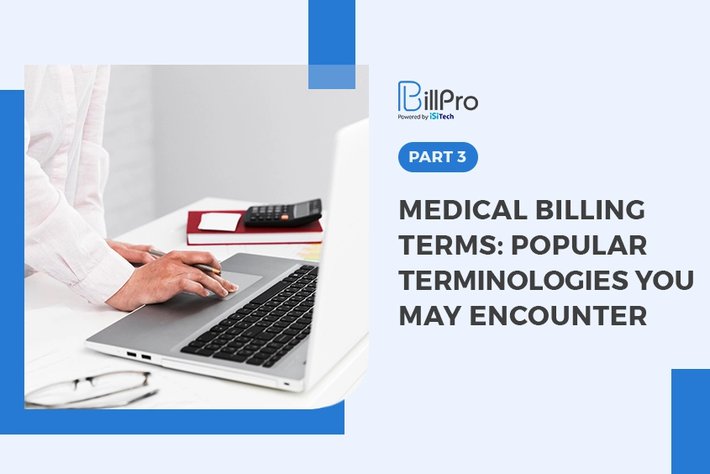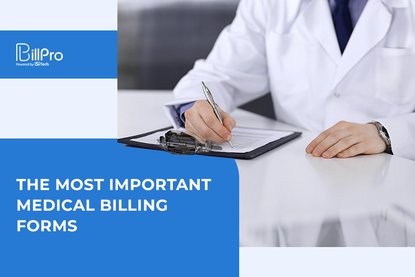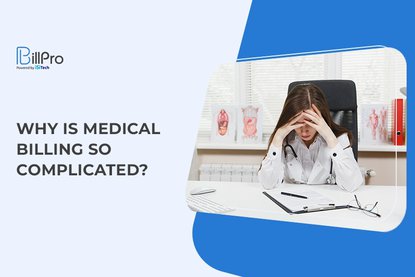The healthcare system has a coding system to simplify the billing process. Medical billing and coding allow the medical industry to bill clients and insurance providers accurately while reporting all diagnoses, treatments, procedures, and medications for a patient.
Medical billing and coding have their own terminologies to ensure uniformity. Billers and coders have to be apprised of important billing terms to appropriately and quickly assign codes to aid the billing process as well as provide clear and correct medical information to healthcare staff.
In part three of our popular medical billing terms, we tackle four more important terms that are often used in medical billing and coding.
Popular Medical Billing Terms
Most of the medical bills in the U.S. are paid by third-party organizations, such as insurance providers and government programs like Medicare and Medicaid. To sort the bill, medical billers and coders have to go through different documents and medical reports. These files contain dozens of terms that are only used in the medical billing and coding field.
Here are some of the more commonly used terms in medical billing:
NCCI
What is NCCI in medical billing?
NCCI refers to the National Correct Coding Initiative of the Centers for Medicare and Medicaid Services (CMS). The goal is to reduce or get rid of any coding mistakes due to wrong methodologies that may result in improper Medicare payments or Medicaid claims.
The Medicare Administrative Contractors (MACs) use NCCI medically unlikely edits (MUEs) to reduce or eliminate incorrect payments for Part B claims which constitute:
-
Ambulance services
-
Doctor’s services
-
Home healthcare (selected)
-
Medical supplies and equipment
-
Outpatient hospital care
-
Outpatient physical therapy
-
Outpatient speech therapy
CMS shares most MUE values through its website but some are considered confidential. Note that the confidentiality of these values may change with time. You can remain updated by checking quarterly updates to the NCCI MUE.
There are two NCCI edits that refer to changes that prevent overpayment:
Physician Edits
The NCCI has two columns where doctors and medical practitioners apply necessary code pair edits. The columns are also used by ambulatory surgery centers.
Hospital Outpatient Edits
These edits are for hospitals, home health agencies, skilled nursing facilities, comprehensive outpatient rehabilitation facilities, speech-language pathology providers, and outpatient physical therapy.
FQHC
What is an FQHC in medical billing?
The acronym stands for Federally Qualified Health Center. The United States Department of Health and Human Services, through the Bureau of Primary Health Care and CMS, designates community-based organizations as outpatient clinics referred to as FQHC. The center handles many health programs funded by the Health Center Consolidation Act and is qualified to receive specific reimbursements from Medicare or Medicaid.
FQHC provides various services despite a patient’s ability to pay or health insurance status. Services include:
-
Comprehensive primary care
-
Preventative care
-
Oral care
-
Mental healthcare
-
Substance abuse service
-
Hospital and specialty care
In some cases, the center also provides transportation services for complete patient care.
Most FQHCs work with various organizations to provide specialized care that may extend beyond the healthcare facility’s abilities. For example, a center may work with behavioral health centers to provide mental healthcare and substance abuse services to FQHC clients.
Moreover, FQHC has become an umbrella of services that offers specific programs:
-
Community health centers provide primary care services to people within federally designated medically underserved areas/populations (MUAs or MUPs).
-
Migrant health centers have culturally competent representatives who cater to migrant and seasonal agricultural laborers. These representatives can communicate with workers in their local language, making them more comfortable in sharing health issues.
-
Healthcare for the homeless programs reach out to people who don’t have homes. The service provides them with primary and preventative care as well as substance abuse services.
-
Public housing primary care programs provide primary and preventative care to residents of public housing.
Lockbox Payment
What is lockbox payment in medical billing?
A literal lockbox is a steel box with a lock to secure the cash. A lockbox in medical billing uses the same concept. It is a bank-provided service that enables the management of collections and deposits to streamline payment and reconciliation procedures. It helps organizations maintain more efficient systems while adhering to deadlines.
Why use the lockbox payment system in healthcare?
-
Automation makes it faster.
-
Claims are paid out more quickly.
-
The system uses virtual workflows for easy communication and posting.
-
Online access is available for years, usually corresponding to the legal requirement for keeping medical records.
-
It decreases the potential for duplicate posting.
-
Lockbox systems reduce the risks of error, fraud, and theft.
But these reasons are only as good as their lockbox providers. You need a reliable bank with experience in providing a one-stop-shop service for managing payments.
Downcoding
What is downcoding in medical billing?
The downcoding medical definition is the process of lowering the value of a claim originally submitted by the physician. It usually happens when the code is not mentioned in the billing because there isn’t enough evidence that the medical service was performed.
Downcoding can be the subject of legal action or fraud.
According to the American Medical Association, many payers have resorted to downcoding while using claim-editing software. The software supposedly does the downcoding through an algorithm instead of reviewing the reports or records.
Certain software can combat the illegal practice of downcoding. Medical billing software like BillPro simplifies the billing process while eliminating errors. Should errors be identified, the software will easily correct them.
Aside from mitigating downcoding through software, here are other measures that can help you prevent it:
Documentation
Complete and accurate documentation prevents downcoding while providing evidence that the services rendered were necessary for the health of the patient.
Coding Audits
Auditors review and analyze codes to prevent downcoding and upcoding. This can get rid of or reduce any errors in the claims.
Know the Fee Schedules
CMS provides a fee schedule or a comprehensive list of the fees Medicare uses to pay physicians and other healthcare providers.
Insurance Verification
Verifying a patient’s insurance claim allows you to identify accepted and approved codes which will help you code accurately and avoid downcoding.
Conclusion
 The medical billing process is complex. Medical billers and coders need great attention to detail to ensure errors are minimized or eliminated. One way to do so is to be familiar with the popular medical billing terms used in healthcare facilities.
The medical billing process is complex. Medical billers and coders need great attention to detail to ensure errors are minimized or eliminated. One way to do so is to be familiar with the popular medical billing terms used in healthcare facilities.
Familiarity with medical terminology and the use of medical billing software promotes efficiency at work with less time spent correcting mistakes or reeling from the fallout of such errors. If you’re looking for software that specializes in New York Medicaid billing services, book a demo with BillPro.
P.S. Here you can find the second part of popular medical billing codes.

 5/5 (1 vote)
5/5 (1 vote)
 217 views
217 views



